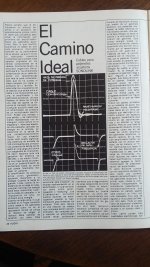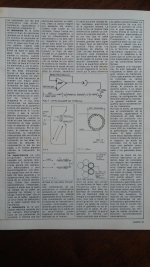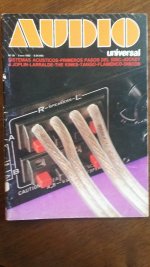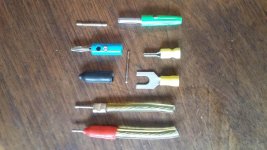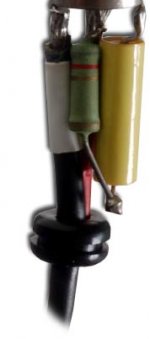Academia50, what is the question? You do have to be specific. How does it relate to harmonic distortion measurements being discussed here?
Last edited:
Cable resistance worsens damping, although not by much.turk 182 said:closer to topic if cable resistance worsens damping and produces distortion can we use the subjective terms "loose" to describe inadequate damping (?) and "sloppy" as additional distortion(?)
Cable resistance does not produce distortion, as I keep saying. It merely makes it visible to a measuring instrument.
Academia50, what is the question? You do have to be specific. How does it relate to harmonic distortion measurements being discussed here?
To comment here we should speak exclusively of measurements ? 🙄
If you read the link you will see that it is on a speaker cable considered excellent by some diyer's Obviously within that sonorous excellence is included the harmonic distortion, for which my concern is totally related to the title of this thread. It's not off, it's in topic 100% -
I humbly and praising the thread I just asked for some opinion, I was waiting to know if someone use or build a braided cable like the one I went up and drew conclusions, etc.
So you do not see it that way, and you ask me the relationship? You're making me a joke, right ?
Well, at least it's an answer....
Thanks Mark
Last edited:
Cable resistance worsens damping, although not by much.
Cable resistance does not produce distortion, as I keep saying. It merely makes it visible to a measuring instrument.
true enough thanks for the correction.
I am 100% positive on the fact that cables DO not *produce* any kind of audible distortions. No mystery. No need for silver or I don't know what.To comment here we should speak exclusively of measurements ? 🙄
Hoping that they can have a "SOUND" is believing in pure snake oil.
If you can hear differences between cables, it is because the flaws of your amps and speakers (non linear curves of impedance), and only the serial resistance of a cable and its parasitic capacitance can influence the result. IE their diameter VS lengths. Don't spend your money in esoteric things on this matter: work on your speakers.
so true Tournesol! and without any objective data the premise that left and right hand helical winding produces audible differences is snake oil.
does snake oil come in more refined versions like olive oil? (no virgins should be sacrificed for any kind of oil !!)
does snake oil come in more refined versions like olive oil? (no virgins should be sacrificed for any kind of oil !!)
Virgins, full moon etc...so true Tournesol! and without any objective data the premise that left and right hand helical winding produces audible differences is snake oil.
Long long time ago, at the beginning of this cable sound fashion, I had a controversy with a HIfi guru, selling overpriced stuff in his shop. He demonstrated to me the difference between two very good looking and expensive cables. it was audible.
I came, the day after, with a pair of enclosures (i linearize the impedance curve of all my speakers since decades). No difference at all between all the cables he tried.
Blind or not.
Depending of the shoes I wear, I can feel my car more or less "heavy".
Do I have to think some shoes brings more "acceleration" ?
That Belden cable is twisted, braided is usually take to mean similar to plaited like hair, using a minimum of three wires. Twisting reduces EMI pick up, but that is of minimal consequence in such a low impedance circuit. It also reduces the EMI emissions from the cable, again, unlikely to be an issue unless it's run close to small signal wires for a long distance.I was waiting to know if someone use or build a braided cable like the one I went up and drew conclusions, etc.
To comment here we should speak exclusively of measurements ? 🙄
If you read the link you will see that it is on a speaker cable considered excellent by some diyer's Obviously within that sonorous excellence is included the harmonic distortion, for which my concern is totally related to the title of this thread. It's not off, it's in topic 100% -
I humbly and praising the thread I just asked for some opinion, I was waiting to know if someone use or build a braided cable like the one I went up and drew conclusions, etc.
So you do not see it that way, and you ask me the relationship? You're making me a joke, right ?
Well, at least it's an answer....
Thanks Mark
This thread is really not about cables. That is why you probably didn't get a response to your questions. You will have more luck starting your own thread.
No joke intended. I get misunderstood all the time.
Last edited:
Virgins, full moon etc...
Long long time ago, at the beginning of this cable sound fashion, I had a controversy with a HIfi guru, selling overpriced stuff in his shop. He demonstrated to me the difference between two very good looking and expensive cables. it was audible.
I came, the day after, with a pair of enclosures (i linearize the impedance curve of all my speakers since decades). No difference at all between all the cables he tried.
Blind or not.
Depending of the shoes I wear, I can feel my car more or less "heavy".
Do I have to think some shoes brings more "acceleration" ?
But most speakers are not linearized for impedance. That’s in fact a rarity and quite expensive extras to the filter circuit. For most non linear impedance crossovers, a low impedance cable will have an audible effect.
Impedance linearity notwithstanding, the actual amplifier output impedance or DF is tremendously impacted by cable type.
I did this test myself recently in trying to measure my amplifier’s DF.
Connected a high impedance load (540ohms) and set output to be 10vpp, and then connected low impedance load (8ohms) and measured voltage droop. Used formula to calculate DF. When using 16ga high quality stranded copper 1.5m long cable, DF was 5. With Romex 12ga solid copper, DF was 30. That’s a big change and very noticeable when listening.
It is the cable having an audible effect on the speaker’s sound output. No question. I am not saying use high priced fairy dust cables. Just thicker gauge lower impedance ones.
0.039 ohm wire to 0.016 ohm wire is not a big change versus an 8 ohm load.Connected a high impedance load (540ohms) and set output to be 10vpp, and then connected low impedance load (8ohms) and measured voltage droop. Used formula to calculate DF. When using 16ga high quality stranded copper 1.5m long cable, DF was 5. With Romex 12ga solid copper, DF was 30. That’s a big change and very noticeable when listening.
DF from 5 to 30 would need a cable resistance decrease of more than 1 ohm.
Those are average ohms/m values published for some standard wire at DC. What is it as a function of frequency and under rather high current. Try measuring your amp’s DF at the end of the wire and see what you get.
In post #332, I simply used:
Zwire = 17* L / S ( with Zwire in milliOhm, L in meter, S in square millimeter )
and
Zout + Zwire = Zload / DF
( with Zout whatever amplifier output impedance, Zload: 8 Ohm rated speaker ).
Zwire = 17* L / S ( with Zwire in milliOhm, L in meter, S in square millimeter )
and
Zout + Zwire = Zload / DF
( with Zout whatever amplifier output impedance, Zload: 8 Ohm rated speaker ).
This thread is really not about cables.
I do not want to contradict you, Mark, but I think you can not atomize a thread by opening others constantly. I do see that there is a relationship.
And I assume the risk that admins delete all this if they do not consider it appropriate or move it to another site.
I will accept the law, although sometimes in the name of it, so many injustices will be committed ! 🙄
This theme for me, given my age and my early fondness for audio stuff, is well known. The measurements are very interesting and real, they can not be denied. It would be foolish that, and I do not think I am. But the mathematical calculations that do not correspond automatically with an audible modification in the sound.
In all this article (any similarity of this cable with Monster Cable of the seventies is NOT pure coincidence 😀 ) the word distortion is not mentioned, I regret that they can not read spanish.
There is talk of treble losses due to the high resistance R, phase displacements caused by capacitance C, and that the inductance L " is the cause of the portion of current of the signal being delayed, taking it out of phase at high frequencies" I do not see this part very clearly. Obviously, it is also spoken of the known film effect, that this cable prevents the high and low frequencies from propagating with the same intensity, etc.. There was still no mention of the OFC ....
The different opinions are not exhausted in the cables, they also include the terminals. They are fashions, a bare wire bitten by a pressure connector like the ones in the photo were excellent connection systems and very simple. In fact, for that photograph, the diameter had to be reduced by eliminating many filaments. I knew the history closely. Now we must buy colorful cables, with attractive color coatings, connector designs that look like works of art (and they are very cute, I accept it). There are those who argue that the terminals should not be soldered, but crimp, that gold terminals should be used, that the bare wire should be used, etc,
I still have and use the cable of the photographs, which has been modified according to my connection needs many times. I have never noticed the slightest difference.
Therefore, my opinion is that the speaker cables do not introduce audible sound differences, which includes the harmonic distortion, obviously.
The only caveat I do is the length and thickness of the driver, I refer to sound systems for the home, and not for long distances as in professional use PA.
There the technique was the use of transformers to compensate for voltage drops. Today, I really do not know if this is still being used, since wireless connections can bypass all the connections.
The best for you. 🙂
Rolando
Attachments
Last edited:
I am 100% positive on the fact that cables DO not *produce* any kind of audible distortions. No mystery. No need for silver or I don't know what.
Hoping that they can have a "SOUND" is believing in pure snake oil.
If you can hear differences between cables, it is because the flaws of your amps and speakers (non linear curves of impedance), and only the serial resistance of a cable and its parasitic capacitance can influence the result. IE their diameter VS lengths. Don't spend your money in esoteric things on this matter: work on your speakers.
I am 100% in agreement. Thanks for your response, you have been very kind.
The best for you too . 😉
Rolando
" OCOS is the first and only loudspeaker cable with absolute constant impedance throughout the entire frequency range, matching that of a normal loudspeaker."
Dynaudio Ocos Ultra Loudspeaker Cable - Custom Cable
Well, zobel networks are well known and often used in frequency divisors. They have their pros and cons, as everything related to xover's is a commitment, it depends how they are implemented in each particular case ....
I wonder how it did not occur to anyone before? Or are you simply using an external zobel network that is used in practice in the frequency divider inside the cabinet? With this admin always the same result is achieved? , that is, to flatten the variations of impedances of any speaker system ? 😕
It sounds like generic frequency networks ...
Dynaudio Ocos Ultra Loudspeaker Cable - Custom Cable
Well, zobel networks are well known and often used in frequency divisors. They have their pros and cons, as everything related to xover's is a commitment, it depends how they are implemented in each particular case ....
I wonder how it did not occur to anyone before? Or are you simply using an external zobel network that is used in practice in the frequency divider inside the cabinet? With this admin always the same result is achieved? , that is, to flatten the variations of impedances of any speaker system ? 😕
It sounds like generic frequency networks ...
" OCOS is the first and only loudspeaker cable with absolute constant impedance throughout the entire frequency range, matching that of a normal loudspeaker."
Not quite- The Polk Cobra Cable form the late 1970's has that distinction. I checked it and confirmed it to be about 8 Ohms impedance. A pain to make and terminate, Unfortunately that makes little difference at audio frequencies.
The relevant test would be the difference in frequency response at each end of the cable connected to a particular speaker. Level doesn't matter since the currents are not approaching anything that would alter the resistance of the wire. For the capacitance to matter it would need to be quite large or just right to get the amp oscillating. That would suggest the speaker is pretty inductive at higher frequencies (most are). In the end the cable is series resistance and series inductance between the amp (should be ideal voltage source) and speaker (not an ideal resistor).
I have made cables with constructions that lower the inductance and they make a difference. But not enough volume to be a business where I was doing the work. Today the vast majority of speakers are self powered with digital amps and crossovers. No opportunity to sell speaker cables.
- Status
- Not open for further replies.
- Home
- Amplifiers
- Solid State
- Speaker cables don't influence harmonic distortion!
